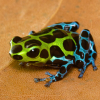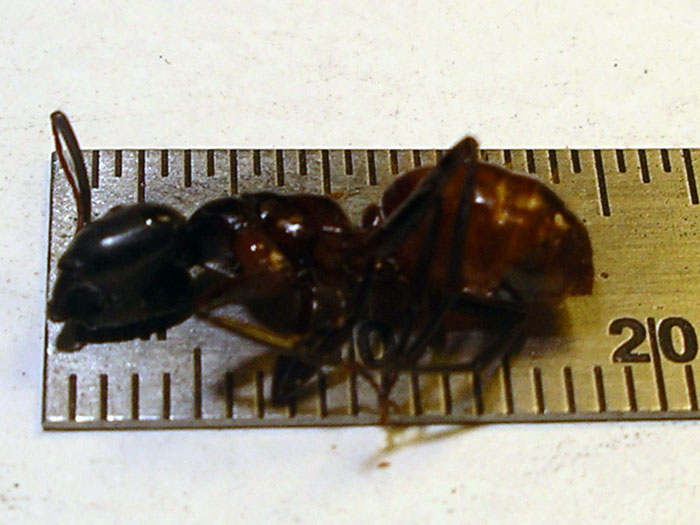Largest I've seen is camponotus quersicola but I'm very new to anting
What's the biggest?

Largest I've seen is camponotus quersicola but I'm very new to anting
What's the biggest?
Probably large Camponotus species. The queens are huge! The biggest I've personally seen of any California ant, along with the biggest majors I've seen of any ant. I've seen some that were the size of bees.
I don't think there are any larger sized ants in California. At least nothing I've seen or read about. There is Atta (which can be found in some areas of the US), which of course have massive queens. But, they aren't found in California.
My personal favorite are Camponotus modoc, which make huge colonies and huge queens+majors. They can be found in Northern California. Very common up there.
Edited by Vendayn, March 21 2017 - 12:15 PM.
Yeah, the largest are Camponotus queens. I would say probably the HUGE species I see in the hills around here. I am not exactly sure what they are, though I think they might be C. ocreatus.
Here's how large the majors are. Queens are normally just a little larger than the largest majors.

Yeah, the largest are Camponotus queens. I would say probably the HUGE species I see in the hills around here. I am not exactly sure what they are, though I think they might be C. ocreatus.
Here's how large the majors are. Queens are normally just a little larger than the largest majors.
Wow! Where can I found a list of all the ants in Nebraska!?
Yeah, the largest are Camponotus queens. I would say probably the HUGE species I see in the hills around here. I am not exactly sure what they are, though I think they might be C. ocreatus.
Here's how large the majors are. Queens are normally just a little larger than the largest majors.
Wow! Where can I found a list of all the ants in Nebraska!?
- Aphaenogaster fulva
- Aphaenogaster rudis
- Aphaenogaster tennesseensis
- Aphaenogaster treatae
- Brachymyrmex depilis
- Camponotus americanus
- Camponotus caryae
- Camponotus chromaiodes
- Camponotus decipiens
- Camponotus discolor
- Camponotus nearcticus
- Camponotus novaeboracensis
- Camponotus pennsylvanicus
- Camponotus sayi
- Camponotus vicinus
- Crematogaster cerasi
- Crematogaster lineolata
- Crematogaster missouriensis
- Dorymyrmex flavus
- Dorymyrmex insanus
- Dorymyrmex pyramicus
- Dorymyrmex smithi
- Forelius pruinosus
- Formica argentea
- Formica bradleyi
- Formica comata
- Formica dakotensis
- Formica densiventris
- Formica dolosa
- Formica fossaceps
- Formica fusca
- Formica incerta
- Formica integra
- Formica integroides
- Formica lasioides
- Formica limata
- Formica montana
- Formica neoclara
- Formica neogagates
- Formica neorufibarbis
- Formica obscuripes
- Formica obtusopilosa
- Formica oreas
- Formica pallidefulva
- Formica pergandei
- Formica podzolica
- Formica puberula
- Formica ravida
- Formica rubicunda
- Formica subaenescens
- Formica subsericea
- Formica vinculans
- Hypoponera opacior
- Lasius alienus
- Lasius claviger
- Lasius flavus
- Lasius interjectus
- Lasius latipes
- Lasius murphyi
- Lasius nearcticus
- Lasius neoniger
- Lasius niger
- Lasius occidentalis
- Lasius umbratus
- Monomorium minimum
- Myrmecina americana
- Myrmica americana
- Myrmica brevispinosa
- Myrmica fracticornis
- Myrmica punctiventris
- Neivamyrmex kiowapache
- Neivamyrmex nigrescens
- Nylanderia arenivaga
- Nylanderia parvula
- Nylanderia terricola
- Pheidole bicarinata
- Pheidole inquilina
- Pheidole pilifera
- Pogonomyrmex occidentalis
- Polyergus bicolor
- Polyergus breviceps
- Polyergus montivagus
- Ponera pennsylvanica
- Prenolepis imparis
- Solenopsis molesta
- Stenamma brevicorne
- Stenamma diecki
- Tapinoma sessile
- Temnothorax ambiguus
- Temnothorax curvispinosus
- Temnothorax pergandei
- Temnothorax schaumii
- Temnothorax tricarinatus
What type of Camponotus are in western Washington?
0 members, 0 guests, 0 anonymous users